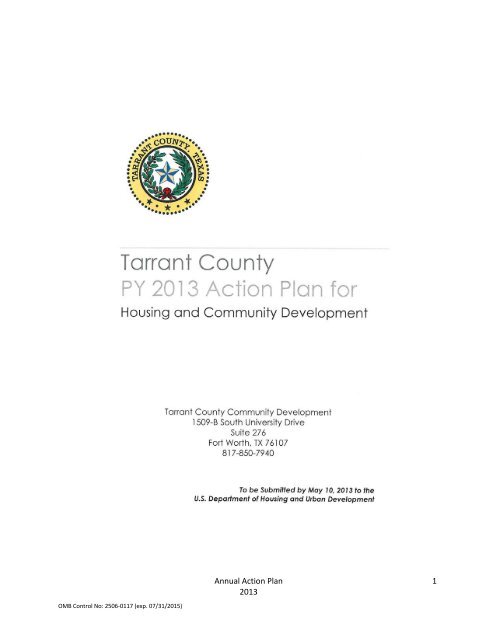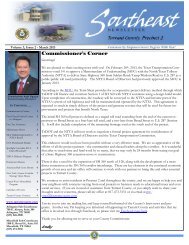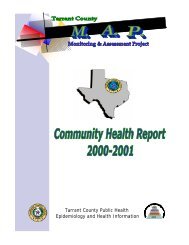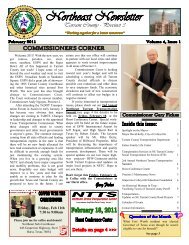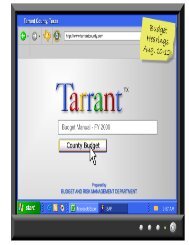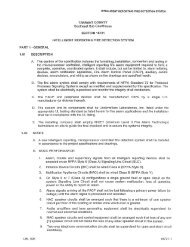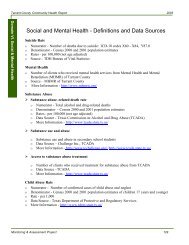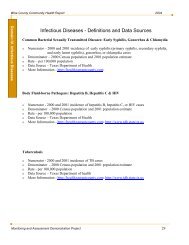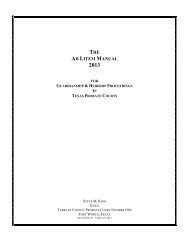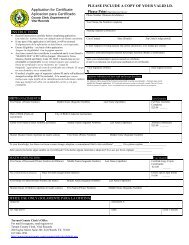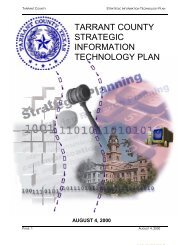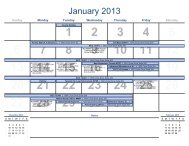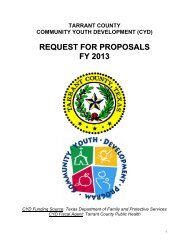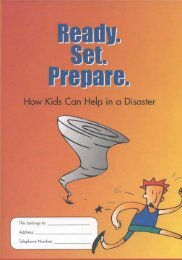PY 2013 Action Plan - Draft - Tarrant County
PY 2013 Action Plan - Draft - Tarrant County
PY 2013 Action Plan - Draft - Tarrant County
You also want an ePaper? Increase the reach of your titles
YUMPU automatically turns print PDFs into web optimized ePapers that Google loves.
Annual <strong>Action</strong> <strong>Plan</strong><br />
<strong>2013</strong><br />
1<br />
OMB Control No: 2506‐0117 (exp. 07/31/2015)
Executive Summary<br />
ES‐05 Executive Summary<br />
1. Introduction<br />
<strong>PY</strong> <strong>2013</strong> is the fourth action plan of the <strong>Tarrant</strong> <strong>County</strong> Consortia five‐year 2010‐2014 Consolidated <strong>Plan</strong>.<br />
The Consolidated <strong>Plan</strong>ning process combines the application, planning, and reporting requirements for<br />
Community Development Block Grant (CDBG), HOME Investment Partnership Program (HOME), and the<br />
Emergency Solutions Grant (ESG). As an Urban Entitlement <strong>County</strong>, <strong>Tarrant</strong> <strong>County</strong> must comply with<br />
the Consolidated <strong>Plan</strong> requirements in order to receive funding for these formula‐based HUD programs.<br />
Designated as the lead agency by the <strong>Tarrant</strong> <strong>County</strong> Commissioners Court, the Community<br />
Development Division (CDD) of the <strong>County</strong> Administrator's Office is charged with the preparation and<br />
the submission of this <strong>Action</strong> <strong>Plan</strong> to HUD on behalf of <strong>Tarrant</strong> <strong>County</strong> Urban entitlement as well as four<br />
entitlement cities; City of Euless, City of Grapevine, City of Mansfield and City of North Richland Hills.<br />
The CDD is also responsible for overseeing the public notification process, approval of projects, and the<br />
administration of these grants. <strong>Tarrant</strong> <strong>County</strong> published a Public Notice announcing and summarizing<br />
the proposed <strong>Draft</strong> <strong>Action</strong> <strong>Plan</strong> for <strong>PY</strong> <strong>2013</strong> in the Commercial Recorder on March 22, <strong>2013</strong>, opening the<br />
30‐day public comment period, concluding on April 23, <strong>2013</strong>. A public hearing will be held on April 23,<br />
2012 at <strong>Tarrant</strong> <strong>County</strong> Commissioners Court, 10:00am. Comments will be provided in the final submital<br />
of the <strong>Action</strong> <strong>Plan</strong>. Activities to be funded under each program are described within the <strong>Action</strong> <strong>Plan</strong>. The<br />
Mayors' Council of <strong>Tarrant</strong> <strong>County</strong> will review the <strong>Action</strong> <strong>Plan</strong> on April 1, <strong>2013</strong>. The resolution will be<br />
found in the apendices in the final <strong>Action</strong> <strong>Plan</strong>. The CDD staff will prepare an environmental review of<br />
the projects under the plan and will comply with all consultation and public notice requirements. The<br />
Environmental Review Record is on file at the <strong>Tarrant</strong> <strong>County</strong> Community Development office.<br />
2. Summary of the objectives and outcomes identified in the <strong>Plan</strong> Needs Assessment<br />
Overview<br />
<strong>Tarrant</strong> <strong>County</strong> activities will address the objectives of providing low and moderate‐income residents<br />
with a suitable living environment and decent affordable housing. The following are activities in which<br />
<strong>Tarrant</strong> <strong>County</strong> will focus on for <strong>PY</strong><strong>2013</strong>.<br />
• An estimated $2,193,540.00 of <strong>PY</strong> <strong>2013</strong> CDBG funds for Public Infrastructure Improvement<br />
activities under area wide benefits which includes $110,000. for program delivery. $255,858.98<br />
in previous year's CDBG funds will be reallocated for 39th year activities also. In <strong>PY</strong> <strong>2013</strong>, at least<br />
9,540 persons in 12 cities and approximtely 3,000 people under the limited clientele<br />
Annual <strong>Action</strong> <strong>Plan</strong><br />
<strong>2013</strong><br />
2<br />
OMB Control No: 2506‐0117 (exp. 07/31/2015)
qualification within the City of Euless will be assisted with improved access to infrastructure<br />
benefits.<br />
• An estimated $454,058. in CDBG funds plus $5,880 in CDBG Program Income for Owner<br />
Occupied Housing Rehabilitation activities will provide for the availability and accessibility of<br />
decent housing for an estimated 14 households and to maintain the program.<br />
• An estimated $ 87,000 in CBDG funds will be used for CDBG Public Service activities for<br />
supportive housing services and case management to provide for the availability and<br />
accessibility of decent housing to approximately 25 households. The supportive housing<br />
positions are responsible for outreach and enrolling homeless individuals and families into the<br />
<strong>Tarrant</strong> <strong>County</strong> Transitional Housing Program.<br />
• An estimated $42,000 in CBDG funds will be used for SafeHaven of <strong>Tarrant</strong> <strong>County</strong>'s SafeSchool<br />
Program. The program will provide for one staff person to provide evidence‐based curricula to<br />
decrease teen violence, bullying and child abuse to youth and low income persons/households.<br />
The grant funding for <strong>PY</strong><strong>2013</strong> will serve approximately 2,000 duplicated youth.<br />
• An estimated $ 120,849.00 for ESG Homeless Emergency Shelter activities will provide<br />
accessibility for the purpose of providing availability and accessibility to a suitable living<br />
environment for approximately 10,200 homeless individuals at nighttime and daytime shelters<br />
at five emergency shelter facilities receiving ESG operational, utility cost and essential service<br />
assistance.<br />
• An estimated $ 63,460. for ESG Rapid Re‐Housing to provide housing relocation and stabilization<br />
for people and families who are literally homeless. Short and medium term financial rental<br />
assistance and services such as case management to stabilize approximately 4 families.<br />
• An estimated $ 2,000 for ESG HMIS data administration, reporting and training. Funds will be<br />
used for salaries for HMIS operation, providing Technical support, training and maintenance of<br />
software and production of reports when requested. Costs will be based on a flat fee to produce<br />
requested reports, training and technical assistance and additional fees based on the number of<br />
unduplicated clients served within a year.<br />
• Estimated $ 629,500 ($503,600 HOME funds plus 25% non‐federal match) for HOME CHDO set<br />
aside for to construct 2 new single family homes and acquire/rehabilitate and resell two single<br />
family properties. All four homes will provide down payment and closing cost assistance not to<br />
exceed $10,000 for households that are at or below the 80% Median Income level as well as<br />
meet all HOME requirements.<br />
• $45,000 for CHDO operating expenses to pay for the operation of the community housing<br />
development organization. Such costs include salaries, wages and other employee benefits,<br />
rent, utilities, communication costs and etc.<br />
• Approximately $ 368,578 ($283,522 in HOME funds plus a minimum of 25% non‐federal match)<br />
for Owner Occupied Home Rehabilitation activities will provide for the availability and<br />
accessibility of decent housing for approximately 7 households. Participating cities who will<br />
meet the 30% match will participate under HOME funds. Under <strong>PY</strong><strong>2013</strong> funding, these cities<br />
include; Euless, Hurst and White Settlement.<br />
Annual <strong>Action</strong> <strong>Plan</strong><br />
<strong>2013</strong><br />
3<br />
OMB Control No: 2506‐0117 (exp. 07/31/2015)
3. Evaluation of past performance<br />
Community Development Block Grant: Upon submission of the <strong>PY</strong> <strong>2013</strong> <strong>Action</strong> <strong>Plan</strong>, <strong>Tarrant</strong> <strong>County</strong> will<br />
be in the tenth month of year three of the five‐year 2010‐2015 consolidated plan. To date, the<br />
timeliness expenditure rate for CDBG is below the threshold of 1.50% as required by HUD. Of the public<br />
works projects that were drawn down; all public works projects within the <strong>PY</strong> 2010 <strong>Action</strong> <strong>Plan</strong> are<br />
completed. In <strong>PY</strong>2011, all projects were completed, except for eight. All <strong>PY</strong>2012 projects are underway<br />
for bid or construction with two already completed. Fourty‐one owner occupied home rehabilitations<br />
were completed through the CDBG and HOME programs in <strong>PY</strong> 2011. As of March 1, <strong>2013</strong> in <strong>PY</strong> 2012; 26<br />
are complete, 6 are in rehabilitation, 8 homeowners are currently undergoing eligibility verification, 3<br />
are out for contract bidding, and 5 homes are ready for initial inspection. The public service projects;<br />
SafeSchools program with SafeHaven helps to fund salaries for staff that help educate elementary and<br />
high school students regarding bullying and anti‐violence. Funds for public services assisted 71 persons<br />
(20 families and 7 single persons) with temporary transitional housing to date in <strong>PY</strong>2011. Goals are to<br />
help families become self‐sustaining at the end of the program year.<br />
Emergency Solutions Grant Program: The ESG prevention program continue to serve families in crisis,<br />
and have developed a well networked program with other emergency assistance families to assure well<br />
documented and coordination of services to maximize the number of families being assisted and pooling<br />
the limited resources when able. ESG funds for emergency shelters are expended for <strong>PY</strong> 2011 and<br />
<strong>PY</strong>2012, with some HMIS, rapid rehousing and prevention funds remaining for both years. As ESG funds<br />
must be expended in two years, an evaluation will occur in July <strong>2013</strong> to find if there are difficulties in<br />
expending <strong>PY</strong>2011 and <strong>PY</strong>2012 funding. To date, some funds originally for HMIS will be reallocated to<br />
rapid rehousing due to new guidance from HUD in February <strong>2013</strong>. ESG funds used to offset emergency<br />
shelter operations have been used in a timely manner by all shelter agencies. Increases in utility costs<br />
across the nation demonstrate the strong need for this type of operational assistance to maintain the<br />
<strong>Tarrant</strong> <strong>County</strong> emergency shelters.<br />
HOME Program: As of March 1, <strong>2013</strong> in <strong>PY</strong> 2012; 26 single‐family owner occupied home rehabilitations<br />
are complete, 6 are in rehabilitation, 8 homeowners are currently undergoing eligibility verification, 3<br />
are out for contract bidding, and 5 homes are ready for initial inspection. To date, TCHP and DCTC (both<br />
<strong>Tarrant</strong> <strong>County</strong> CHDO's) are contracted to acquire, rehabilitate and resell or rent approximately 25 single<br />
family units and/or multi‐family units. DCTC acquired "Cornerstone Apartments"; a 74 unit multi‐family<br />
complex in Haltom City. Sixty‐one of those units are HOME qualified.<br />
4. Summary of citizen participation process and consultation process<br />
<strong>Tarrant</strong> <strong>County</strong> encourages citizen participation in the development of its Consolidated <strong>Plan</strong>, particularly<br />
in low/moderate income target areas. Public notices are prepared and public meetings held in<br />
accordance with established <strong>County</strong> policy that calls for at least two public meetings a year. Public<br />
comments are heard in each of our consortium cities where CDBG funds will be expended. Notices were<br />
Annual <strong>Action</strong> <strong>Plan</strong><br />
<strong>2013</strong><br />
4<br />
OMB Control No: 2506‐0117 (exp. 07/31/2015)
distributed through the <strong>Tarrant</strong> <strong>County</strong> Homeless Coalition list serve that is distributed to hundreds of<br />
individuals within the social services community representing over seventy agencies, government, faith<br />
based organizations and private businesses. Lastly, public hearings are held and comments heard at<br />
Commissioner's Court. Inviting representative organizations to public hearings encourages participation<br />
of disabled, minority, and other special populations. Other specific measures may be taken to ensure<br />
that residents of public housing and low/moderate income target areas are informed of public meetings.<br />
The <strong>Tarrant</strong> <strong>County</strong> and Fort Worth Housing Authority personnel are also informed of notices and<br />
meetings to ensure information is distributed to interested persons served by these agencies. Public<br />
notification of all hearings takes place at least ten (10) days prior to the hearing date. Hearings are held<br />
at central locations, which are convenient to residents and accessible to persons with disabilities and in<br />
public areas. For hearings where a significant number of non‐English‐speaking residents are anticipated,<br />
interpreters will be provided. The county citizen participation policy also calls for at least one technical<br />
assistance workshop a year and also publishes all related materials such as the <strong>Action</strong> <strong>Plan</strong>, making them<br />
available at county sub courthouses, CDD Office and on the Internet. Public hearings were held in each<br />
of the urban county consortium member cities to discuss community development activities.<br />
Notifications of the public meetings were posted by each of the 23 cities submitting Community<br />
Development Block Grant project proposals through their respective city secretary or city administration<br />
offices. The public hearings must have ten (10) days notice and take place prior to completion of the<br />
<strong>County</strong>'s yearly action plan. Verification of the hearing is sent to the <strong>Tarrant</strong> <strong>County</strong> CDD office in the<br />
form of certified minutes from the public hearing and a copy of the public notice published in the<br />
jurisdiction's commonly read newspaper. All were found to be in compliance with the Texas Open<br />
Meetings Act (Tex. Government Code Ann. ch. 551, Vernon 1994 & Supp. 2001).<br />
5. Summary of public comments<br />
Notice of the public hearing and a summary of the proposed <strong>PY</strong> <strong>2013</strong> <strong>Action</strong> <strong>Plan</strong> will be published in the<br />
Commercial Recorder on March 22, <strong>2013</strong> and a copy of the <strong>Draft</strong> <strong>Action</strong> <strong>Plan</strong> will be posted on the<br />
<strong>County</strong>'s website the same day. Copies of the draft plan will be available at each sub courthouse building<br />
in <strong>Tarrant</strong> <strong>County</strong>. The public hearing will be held on April 23, <strong>2013</strong> in the <strong>Tarrant</strong> <strong>County</strong> Commissioners<br />
Court. A public notice for Affordable Housing HOME applications and Emergency Solutions Grant (ESG)<br />
applications was distributed in January 15, <strong>2013</strong> and published in the Commercial Recorder and made<br />
available on the internet on the same day. <strong>Tarrant</strong> <strong>County</strong> Homeless Coalition held a communitywide<br />
public forum on February 20, <strong>2013</strong> at the Presbyterian Night Shelter in Fort Worth to address the state<br />
of homelessness. Notice of this meeting was also published on the <strong>Tarrant</strong> <strong>County</strong> and <strong>Tarrant</strong> <strong>County</strong><br />
Homeless Coalition website, included in all mail outs and materials related to the homeless. Last year's<br />
homeless forum had 138 persons were in attendance; approximately 27 persons present were<br />
experiencing homelessness, various funding agencies, citizens and Homeless Service Providers. (New<br />
numbers will be released in the final <strong>Action</strong> <strong>Plan</strong>.) The forum included a presentation of the results from<br />
the Point in Time Count executed on January 24, <strong>2013</strong> as well as open comments and questions<br />
regarding homeless issues. Those comments and the <strong>2013</strong> Continuum of Care Public Forum Report will<br />
be available in the Appendix in the final <strong>Action</strong> <strong>Plan</strong>.<br />
Annual <strong>Action</strong> <strong>Plan</strong><br />
<strong>2013</strong><br />
5<br />
OMB Control No: 2506‐0117 (exp. 07/31/2015)
6. Summary of comments or views not accepted and the reasons for not accepting them<br />
None<br />
7. Summary<br />
Annual <strong>Action</strong> <strong>Plan</strong><br />
<strong>2013</strong><br />
6<br />
OMB Control No: 2506‐0117 (exp. 07/31/2015)
PR‐05 Lead & Responsible Agencies<br />
1. Agency/entity responsible for preparing/administering the Consolidated <strong>Plan</strong><br />
The following are the agencies/entities responsible for preparing the Consolidated <strong>Plan</strong> and<br />
those responsible for administration of each grant program and funding source.<br />
Agency Role Name Department/Agency<br />
Lead Agency<br />
TARRANT COUNTY<br />
Table 1 – Responsible Agencies<br />
Narrative<br />
As an Urban Entitlement <strong>County</strong>, <strong>Tarrant</strong> <strong>County</strong> must comply with the Consolidated/<strong>Action</strong> <strong>Plan</strong><br />
requirements in order to receive funding for formula‐based HUD programs. Designated as the lead<br />
agency by the <strong>Tarrant</strong> <strong>County</strong> Commissioners Court, the Community Development Division (CDD) of the<br />
<strong>County</strong> Administrator's Office is charged with the preparation and the submission of this<br />
Consolidated/<strong>Action</strong> <strong>Plan</strong> to HUD. Additionally, under contract with four entitlement cities receiving<br />
CDBG funds within <strong>Tarrant</strong> <strong>County</strong>, it is <strong>Tarrant</strong> Count's role to also report and administer CDBG funds<br />
on behalf of the Cities of Euless, Grapevine, Mansfield and North Richland Hills. The CDD is also<br />
responsible for overseeing the public notification process, approval of projects, and the administration<br />
of these grants.<br />
Consolidated <strong>Plan</strong> Public Contact Information<br />
Questions and comments may be mailed to Patricia Ward, Director, <strong>Tarrant</strong> <strong>County</strong> Community<br />
Development Division, 1509‐B South University Drive, Suite 276, Fort Worth, TX 76107 or call (817) 850‐<br />
7940.<br />
Annual <strong>Action</strong> <strong>Plan</strong><br />
<strong>2013</strong><br />
7<br />
OMB Control No: 2506‐0117 (exp. 07/31/2015)
AP‐10 Consultation<br />
1. Introduction<br />
<strong>Tarrant</strong> <strong>County</strong> Community Development Division (CDD) has been designated as the lead agency for the<br />
development and implementation of the <strong>Tarrant</strong> <strong>County</strong> five year Consolidated <strong>Plan</strong>. Priorities are<br />
determined with input from numerous agencies, organizations, and individuals interested in improving<br />
neighborhoods. An on‐going mission of the CDD is to assist and coordinate the work of housing and<br />
community development providers operating in the <strong>County</strong>¿s jurisdiction.<br />
Summary of the jurisdiction’s activities to enhance coordination between public and assisted<br />
housing providers and private and governmental health, mental health and service agencies<br />
Priorities for non‐housing and housing programs were established by the Mayors¿ Council of <strong>Tarrant</strong><br />
<strong>County</strong>. Special needs populations and the homeless priorities were established through the Continuum<br />
of Care process and the <strong>Tarrant</strong> <strong>County</strong> Homeless Coalition. All priorities are reviewed and discussed at<br />
<strong>Tarrant</strong> <strong>County</strong> workshops, public forums, and public hearings held throughout the year.<br />
The Mayors¿ Council is briefed by the Community Development Director on housing and community<br />
development issues at each of its six meetings per year. The CDD also staffs the Mayors¿ Council and its<br />
sub‐committees maintaining a constant dialogue among urban county consortium members.<br />
The CDD attends the <strong>Tarrant</strong> Regional Transportation Coalition meetings, a regional planning and<br />
advisory body addressing transportation issues such as federal and state funding, air quality mandates,<br />
proposed legislation, and other related economic development issues. The coalition meets on a<br />
monthly basis. A primary issue addressed by the coalition directly related to the needs of low income<br />
residents is the development of mass transit strategies including service development, funding, and<br />
regional planning. The CDD participates in all coalition meetings and committees.<br />
Inviting representative organizations to public hearings encourages participation of disabled, minority,<br />
and other special populations. Other specific measures may be taken to ensure that residents of public<br />
housing and low/moderate income target areas are informed of public meetings. The <strong>Tarrant</strong> <strong>County</strong><br />
and Fort Worth Housing Authority personnel are also informed of notices and meetings to ensure<br />
information is distributed to interested persons served by these agencies.<br />
In coordinating with health, mental health and other service agencies, agencies are invited to present<br />
and provide information to the <strong>County</strong> and cities during Mayors¿ Council meetings which are held the<br />
first Monday, every other month throughout the year. If further coordination is required, committees<br />
are formed.<br />
Annual <strong>Action</strong> <strong>Plan</strong><br />
<strong>2013</strong><br />
8<br />
OMB Control No: 2506‐0117 (exp. 07/31/2015)
Describe coordination with the Continuum(s) of Care that serves the jurisdiction's area in<br />
determining how to allocate ESG funds, develop performance standards for and evaluate<br />
outcomes of projects and activities assisted by ESG funds, and develop funding, policies and<br />
procedures for the operation and administration of HMIS<br />
<strong>Tarrant</strong> <strong>County</strong> consulted with the Continuum of Care (CoC) in a meeting held between the CoC, City of<br />
Arlington and the City of Fort Worth to discuss how best to allocate funding amongst our non‐profit<br />
agencies to best serve our clients, performance standards and HMIS data collection. The cities of<br />
Arlington and Fort Worth will only fund agencies within their respective cities to assist those within their<br />
cities. <strong>Tarrant</strong> <strong>County</strong> will provide funding for any agency serving clients anywhere within <strong>Tarrant</strong><br />
<strong>County</strong> outside of the Cities of Arlington and Fort Worth. The <strong>County</strong> will aim to better assist those<br />
outside of Arlington and Fort Worth and provide for those gaps and populations outside of the two<br />
central cities.<br />
<strong>Tarrant</strong> <strong>County</strong> has consulted and will continue to consult with the CoC regarding the performance<br />
standards for activities funded under ESG by discussing how best the HMIS system and the CoC lead<br />
which is the <strong>Tarrant</strong> <strong>County</strong> Homeless Coalition (TCHC) can produce uniform reports for all prime<br />
recipients and provide detailed and improved reports for the ESG program. The consistency with the<br />
consolidated plan, quarterly e‐snaps report, annual action plan and CAPER, will be used as a guide for<br />
which performance standards will be recorded, tracked and produced in monthly or quarterly reports.<br />
The CoC and three grantees within <strong>Tarrant</strong> <strong>County</strong> met March 19, <strong>2013</strong> and the consultation concluded<br />
that the Continuum of Care, lead by <strong>Tarrant</strong> <strong>County</strong>¿s CoC ¿ The <strong>Tarrant</strong> <strong>County</strong> Homeless Coalition<br />
(TCHC) will evaluate each ESG service provider¿s effectiveness, such as how well the service provider<br />
succeeded at: 1) Targeting those who need the assistance most; 2) reducing the number of people living<br />
on the streets or emergency shelters; 3) shortening the time people spend homeless; and 4) reducing<br />
each program participant¿s housing barriers or housing stability risks.<br />
Describe consultation with the Continuum(s) of Care that serves the State in determining how<br />
to allocate ESG funds, develop performance standards for and evaluate outcomes of projects<br />
and activities assisted by ESG funds, and develop funding, policies and procedures for the<br />
operation and administration of HMIS<br />
The Texas Department of Housing and Community Affairs (TDHCA) consulted with several ESG service<br />
providers, including our local Continuum of Care on developing State ESG performance standards. After<br />
consultation with the local Continuum of Care, <strong>Tarrant</strong> <strong>County</strong> chose to adopt TDHCA¿s standards which<br />
is viewable in the ESG section.<br />
Annual <strong>Action</strong> <strong>Plan</strong><br />
<strong>2013</strong><br />
9<br />
OMB Control No: 2506‐0117 (exp. 07/31/2015)
2. Agencies, groups, organizations and others who participated in the process and<br />
consultations<br />
Agency/Group/Organization<br />
<strong>Tarrant</strong> <strong>County</strong> Homeless<br />
Coalition<br />
TARRANT COUNTY<br />
CITY OF FORT WORTH<br />
Agency/Group/Organization<br />
Type<br />
Services‐homeless<br />
<strong>Plan</strong>ning organization<br />
CoC lead<br />
Other government ‐ <strong>County</strong><br />
Other government ‐ Local<br />
Table 2 – Agencies, groups, organizations who participated<br />
What section of the <strong>Plan</strong> was<br />
addressed by Consultation?<br />
Housing Need Assessment<br />
Homelessness Strategy<br />
Homeless Needs ‐ Chronically<br />
homeless<br />
Homeless Needs ‐ Families with<br />
children<br />
Homelessness Needs ‐ Veterans<br />
Homelessness Needs ‐<br />
Unaccompanied youth<br />
Homeless Needs ‐ Chronically<br />
homeless<br />
Homeless Needs ‐ Families with<br />
children<br />
Homelessness Needs ‐ Veterans<br />
Homelessness Needs ‐<br />
Unaccompanied youth<br />
Non‐Homeless Special Needs<br />
Economic Development<br />
Anti‐poverty Strategy<br />
Housing Need Assessment<br />
Homelessness Strategy<br />
Homeless Needs ‐ Chronically<br />
homeless<br />
Homeless Needs ‐ Families with<br />
children<br />
How was the Agency/Group/Organization consulted and what are the anticipated outcomes<br />
of the consultation or areas for improved coordination<br />
All grantees and the CoC lead discussed our needs and type of services expected in return of the HMIS<br />
participation fee for ESG program. To better serve all clients, the nuances of a central Intake system<br />
were discussed to thereby enhancing data collection and being able to better serve our clients. In<br />
coordinating with all service providers, we hope the CoC will be able to creatively create a central intake<br />
system without overburdening human and financial resources.<br />
Identify any Agency Types not consulted and provide rationale for not consulting<br />
OMB Control No: 2506‐0117 (exp. 07/31/2015)<br />
Annual <strong>Action</strong> <strong>Plan</strong><br />
<strong>2013</strong><br />
10
As CoC Lead, the <strong>Tarrant</strong> <strong>County</strong> Homeless Coalition represents all agencies that are members to the<br />
CoC and are aware of needs in the community. Agencies such as Meals on Wheels or services for the<br />
Aging were not formally consulted as ESG funds are specific for homeless populations. However,<br />
through other meetings and networking opportunities clients from Meals on Wheels and <strong>Tarrant</strong> <strong>County</strong><br />
Aging Services were provided with information about <strong>Tarrant</strong> <strong>County</strong> Housing rehabilitation program so<br />
that our services may be provided to those in need.<br />
Other local/regional/state/federal planning efforts considered when preparing the <strong>Plan</strong><br />
Name of <strong>Plan</strong> Lead Organization How do the goals of your Strategic <strong>Plan</strong> overlap with the<br />
goals of each plan?<br />
Continuum of<br />
Care<br />
<strong>Tarrant</strong> <strong>County</strong><br />
Homeless Coalition<br />
The goal of ending homelessness overlaps in our programs and<br />
strategic plans are made accordingly.<br />
Transit<br />
Accessibility<br />
<strong>Plan</strong>ning for<br />
Livable Military<br />
Communities<br />
Narrative<br />
<strong>Tarrant</strong> Riders<br />
Network (TRN)<br />
North Central<br />
Texas Council of<br />
Governments<br />
(NCTCOG)<br />
Lack of transportation affects where a family may live. As such,<br />
<strong>Tarrant</strong> <strong>County</strong> is closely involved with transit accessibility for<br />
those who lack affordable transportation. The TRN is<br />
comprised of providers, interested citizens and agencies that<br />
receive funding and can seek alternate funding to help match<br />
housing needs and transportation needs which affect health,<br />
education and daily living. <strong>Tarrant</strong> <strong>County</strong> will take information<br />
in mind to develop appropriate housing for those who lack<br />
transportation and in seeking other transportation grants<br />
related to housing.<br />
Through a partnership with the North Central Texas Council of<br />
Governments, the Cities of Benbrook, Fort Worth, Lake Worth,<br />
River Oaks, Sansom Park, Westworth Village, and White<br />
Settlement and in conjunction with <strong>Tarrant</strong> <strong>County</strong>, a need<br />
was identified to conduct planning studies for the area<br />
surrounding the Naval Air Station Fort Worth, Joint Reserve<br />
Base (NAS Fort Worth, JRB). The community identified goals to<br />
evaluate transportation options, support economic<br />
development initiatives, evaluate housing and retail markets in<br />
the area, and complete local government comprehensive plan<br />
updates. <strong>Tarrant</strong> <strong>County</strong> CDBG is anticipated to help<br />
implement development plans in the future.<br />
Table 3 – Other local / regional / federal planning efforts<br />
Annual <strong>Action</strong> <strong>Plan</strong><br />
<strong>2013</strong><br />
11<br />
OMB Control No: 2506‐0117 (exp. 07/31/2015)
AP‐12 Participation<br />
1. Summary of citizen participation process/Efforts made to broaden citizen participation<br />
Summarize citizen participation process and how it impacted goal‐setting<br />
Citizen Participation Outreach<br />
Mode of<br />
Outreach<br />
Public<br />
Meeting<br />
Target of<br />
Outreach<br />
homeless<br />
population<br />
Summary of<br />
response/attendance<br />
Summary of comments<br />
received<br />
Summary of<br />
comments not<br />
accepted and<br />
reasons<br />
URL (If applicable)<br />
http://www.ahomewithhope.org/<br />
Public<br />
Meeting<br />
Nontargeted/<br />
broad<br />
community<br />
Each City held public<br />
meetings during monthly city<br />
council meetings to discuss<br />
CDBG projects for this<br />
program year. Meetings<br />
were posted at least 2 weeks<br />
prior to the meeting in<br />
various newspapers.<br />
No negative responses<br />
were made. Some<br />
questions were asked<br />
about time to complete<br />
and work hours, but<br />
responses given were<br />
satisfied by persons<br />
who asked.<br />
All comments were<br />
accepted and<br />
addressed;<br />
however, the<br />
majority of public<br />
meetings had no<br />
public comment.<br />
Public<br />
Meeting<br />
Nontargeted/bro<br />
ad<br />
community<br />
<strong>Tarrant</strong> <strong>County</strong> holds public<br />
meetings at the <strong>County</strong><br />
Commissioner's Court during<br />
regular court sessions<br />
Tuesday mornings.<br />
No comments were<br />
provided. No received.<br />
not applicable.<br />
Annual <strong>Action</strong> <strong>Plan</strong><br />
<strong>2013</strong><br />
12<br />
OMB Control No: 2506‐0117 (exp. 07/31/2015)
Table 4 – Citizen Participation Outreach<br />
Annual <strong>Action</strong> <strong>Plan</strong><br />
<strong>2013</strong><br />
13<br />
OMB Control No: 2506‐0117 (exp. 07/31/2015)
Expected Resources<br />
AP‐15 Expected Resources<br />
Introduction<br />
The primary resources available for the implementation of <strong>Tarrant</strong> <strong>County</strong>’s Consolidated <strong>Plan</strong> are federal funds available through the<br />
Community Development Block Grant (CDBG), the HOME Investment Partnership Program (HOME), and Emergency Solutions Grant (ESG). For<br />
activities affecting the homeless and other special needs populations, <strong>Tarrant</strong> <strong>County</strong> receives Supportive Housing Program (SHP) grant funds<br />
and HOPWA funds by competition. Local social service agencies have other funding streams available to them to carry out their mission within<br />
the community. Additionally, affordable housing projects may be funded through the <strong>Tarrant</strong> <strong>County</strong> Housing Finance Corporation, which has<br />
the authority to issue bonds in support of affordable housing activities.<br />
CDBG funds allocated to projects in each consortium member city are expended within each city according to concentrations of low‐moderate<br />
income persons, designated as CDBG Eligible Areas. CDBG Eligible Areas consist of populations where at least 48.9% of households are<br />
low/moderate income based on the 2000 U.S. Census or at least 51.0% under HUD approved income survey. There are no other specially<br />
designated “Target Areas” in <strong>Tarrant</strong> <strong>County</strong> other than the above mentioned. Other program funds, such as those allocated for the single family<br />
owner occupied home rehabilitation program, represent a direct benefit activity and are allocated on a county‐wide, first‐come, first‐serve basis<br />
to ensure that all low‐income residents will have an equal chance of benefiting from limited resources. For selected housing activities,<br />
geographic locations of projects will be based on the extent of housing need in that area as determined by careful market analyses. Other factors<br />
influencing location of housing projects include the technical capacity of selected non‐profit organizations or housing developers and the ability<br />
of a beneficiary to match effort.<br />
Anticipated Resources<br />
Program<br />
Source of<br />
Funds<br />
OMB Control No: 2506‐0117 (exp. 07/31/2015)<br />
Uses of Funds Expected Amount Available Year 1 Expected<br />
Annual<br />
Allocation:<br />
$<br />
Program<br />
Income:<br />
$<br />
Prior Year<br />
Resources:<br />
$<br />
Total:<br />
$<br />
Amount<br />
Available<br />
Reminder<br />
of<br />
Con<strong>Plan</strong><br />
$<br />
Annual <strong>Action</strong> <strong>Plan</strong><br />
<strong>2013</strong><br />
Narrative Description<br />
14
Program<br />
Source of<br />
Funds<br />
CDBG public ‐<br />
federal<br />
HOME public ‐<br />
federal<br />
ESG public ‐<br />
federal<br />
OMB Control No: 2506‐0117 (exp. 07/31/2015)<br />
Uses of Funds Expected Amount Available Year 1 Expected<br />
Annual<br />
Allocation:<br />
$<br />
Program<br />
Income:<br />
$<br />
Prior Year<br />
Resources:<br />
$<br />
Total:<br />
$<br />
Amount<br />
Available<br />
Reminder<br />
of<br />
Con<strong>Plan</strong><br />
$<br />
Acquisition<br />
Admin and <strong>Plan</strong>ning<br />
Economic<br />
Development<br />
Housing<br />
Public Improvements<br />
Public Services 3,150,923 5,880 255,859 3,412,662 0<br />
Acquisition<br />
Homebuyer assistance<br />
Homeowner rehab<br />
Multifamily rental<br />
new construction<br />
Multifamily rental<br />
rehab<br />
New construction for<br />
ownership<br />
TBRA 924,580 0 1,918,794 2,843,374 0<br />
Conversion and rehab<br />
for transitional<br />
housing<br />
Financial Assistance<br />
Overnight shelter<br />
Rapid re‐housing<br />
(rental assistance) 201,415 0 0 201,415 0<br />
Annual <strong>Action</strong> <strong>Plan</strong><br />
<strong>2013</strong><br />
Narrative Description<br />
All <strong>PY</strong> <strong>2013</strong> funds will be<br />
obligated and should be drawn<br />
down by end of <strong>PY</strong><strong>2013</strong>, June<br />
2014.<br />
All <strong>PY</strong> <strong>2013</strong> funds will be<br />
obligated and should be drawn<br />
down within required HOME<br />
time frames.<br />
All <strong>PY</strong> <strong>2013</strong> funds will be<br />
obligated and should be drawn<br />
down before end of <strong>PY</strong>2014, June<br />
2015.<br />
15
Program<br />
Source of<br />
Funds<br />
Uses of Funds Expected Amount Available Year 1 Expected<br />
Annual<br />
Allocation:<br />
$<br />
Program<br />
Income:<br />
$<br />
Prior Year<br />
Resources:<br />
$<br />
Total:<br />
$<br />
Amount<br />
Available<br />
Reminder<br />
of<br />
Con<strong>Plan</strong><br />
$<br />
Rental Assistance<br />
Services<br />
Transitional housing<br />
Table 1 ‐ Expected Resources – Priority Table<br />
Narrative Description<br />
Explain how federal funds will leverage those additional resources (private, state and local funds), including a description of how<br />
matching requirements will be satisfied<br />
CDBG grants do not require matched funds; however, at least $855,891. will be leveraged (from non‐federal sources) by cities for <strong>PY</strong> <strong>2013</strong> public<br />
facilities projects. The HOME and ESG programs require local match. <strong>PY</strong> <strong>2013</strong> requires matching funds of at least $210,957 for the HOME<br />
program (25% match minimum) and $ 201,415. (100% match) for the ESG program. The 100% match for ESG is provided by each participating<br />
shelter through in‐kind salary costs incurred by shelters, private donations and/or United Way donations. The ESG match for administrative costs<br />
will be matched by <strong>Tarrant</strong> <strong>County</strong> general fund salaries. The minimum 25% match for HOME will be met by participating consortium cities and<br />
CHDO's. These costs are monitored by the <strong>Tarrant</strong> <strong>County</strong> Community Development Division.<br />
If appropriate, describe publically owned land or property located within the jurisdiction that may be used to address the needs<br />
identified in the plan<br />
Not applicable.<br />
Discussion<br />
Annual <strong>Action</strong> <strong>Plan</strong><br />
<strong>2013</strong><br />
16<br />
OMB Control No: 2506‐0117 (exp. 07/31/2015)
Annual Goals and Objectives<br />
AP‐20 Annual Goals and Objectives<br />
Goals Summary Information<br />
Goal Name<br />
Water and Sewer<br />
Improvements<br />
Street<br />
Improvements<br />
Drainage<br />
Improvements<br />
ADA Barrier<br />
Removal<br />
OMB Control No: 2506‐0117 (exp. 07/31/2015)<br />
Start<br />
Year<br />
End<br />
Year<br />
Category<br />
2010 2014 Non‐Housing<br />
Community<br />
Development<br />
2010 2014 Non‐Housing<br />
Community<br />
Development<br />
2010 2014 Non‐Housing<br />
Community<br />
Development<br />
2010 2014 Non‐Housing<br />
Community<br />
Development<br />
Public Services 2010 2014 Homeless<br />
Non‐Homeless<br />
Special Needs<br />
Non‐Housing<br />
Geographic<br />
Area<br />
Annual <strong>Action</strong> <strong>Plan</strong><br />
<strong>2013</strong><br />
Needs Addressed Funding Goal Outcome Indicator<br />
Public Infrastructure<br />
and Facility<br />
Improvements<br />
Public Infrastructure<br />
and Facility<br />
Improvements<br />
Public Infrastructure<br />
and Facility<br />
Improvements<br />
Public Infrastructure<br />
and Facility<br />
Improvements<br />
Public Services<br />
CDBG:<br />
$1,345,899<br />
CDBG:<br />
$341,115<br />
CDBG:<br />
$71,764<br />
CDBG:<br />
$435,763<br />
CDBG:<br />
$129,000<br />
Public Facility or Infrastructure<br />
Activities other than<br />
Low/Moderate Income Housing<br />
Benefit: 6944 Persons Assisted<br />
Public Facility or Infrastructure<br />
Activities other than<br />
Low/Moderate Income Housing<br />
Benefit: 1751 Persons Assisted<br />
Public Facility or Infrastructure<br />
Activities other than<br />
Low/Moderate Income Housing<br />
Benefit: 845 Persons Assisted<br />
Public Facility or Infrastructure<br />
Activities other than<br />
Low/Moderate Income Housing<br />
Benefit: 3000 Persons Assisted<br />
Public service activities other than<br />
Low/Moderate Income Housing<br />
Benefit: 2000 Persons Assisted<br />
Public service activities for<br />
17
Goal Name<br />
Homeowner<br />
Housing<br />
Rehabilitated<br />
Start<br />
Year<br />
End<br />
Year<br />
Category<br />
Community<br />
Development<br />
2010 2014 Affordable<br />
Housing<br />
CHDO Set Aside 2010 2014 Affordable<br />
Housing<br />
Geographic<br />
Area<br />
Needs Addressed Funding Goal Outcome Indicator<br />
Homeowner<br />
Assistance<br />
Rental Assistance<br />
Homeowner<br />
Assistance<br />
CDBG:<br />
$454,058<br />
HOME:<br />
$283,522<br />
HOME:<br />
$503,600<br />
Low/Moderate Income Housing<br />
Benefit: 25 Households Assisted<br />
Homeowner Housing<br />
Rehabilitated: 21 Household<br />
Housing Unit<br />
Homeowner Housing Added: 4<br />
Household Housing Unit<br />
Rapid Rehousing 2010 2014 Homeless Rental Assistance ESG: $63,460 Tenant‐based rental assistance /<br />
Rapid Rehousing: 4 Households<br />
Assisted<br />
Emergency<br />
Shelter<br />
2010 2014 Homeless Maintaining Services<br />
for Homeless<br />
Table 2 – Goals Summary<br />
ESG:<br />
$120,849<br />
Homeless Person Overnight<br />
Shelter: 10200 Persons Assisted<br />
Estimate the number of extremely low‐income, low‐income, and moderate‐income families to whom the jurisdiction will provide<br />
affordable housing as defined by HOME 91.215(b)<br />
<strong>Tarrant</strong> <strong>County</strong> will assist extremely low‐income persons and homeless persons with rapid re‐housing in transitional housing with case<br />
management in hopes to assist persons and families in becoming self‐sufficient and secure permanent housing. Approximately 4 families from<br />
ESG funds and 25 families from CDBG public services funds will be served. The current population at this income level requires rental assistance<br />
to affordable rental properties close to transportation as more of this income level has difficulty in obtaining and maintaining the cost for<br />
personal transportation. A few cases of homeowners that are extremely low‐income may be assisted in our home rehabilitation program, but<br />
very few may be in this income bracket and own their own home. All home rehabilitation will be funded through CDBG or HOME funds.Low<br />
income and moderate‐income persons will be assisted with not only rental assistance where applicable, but in home rehabilitation for those<br />
who own single family units. Approximately 21 units will be rehabilitated using CDBG and HOME funds. Older homes and persons who are aging<br />
Annual <strong>Action</strong> <strong>Plan</strong><br />
<strong>2013</strong><br />
18<br />
OMB Control No: 2506‐0117 (exp. 07/31/2015)
or have disabilities will mainly be assisted as this population would like to age in place, within their homes. By maintaining homes within older<br />
neighborhoods, it will create a sustainable living environment for the home owner and prevent blight in neighborhoods. To add to the housing<br />
stock, 2 new single family homes will be newly constructed and at least 2 single family homes will be acquired/rehabilitated and resold using<br />
CHDO funds. Down payment and closing costs will be available to assist with HOME qualified homeowners.<br />
Annual <strong>Action</strong> <strong>Plan</strong><br />
<strong>2013</strong><br />
19<br />
OMB Control No: 2506‐0117 (exp. 07/31/2015)
Projects<br />
AP‐38 Project Summary<br />
Project Summary Information<br />
Project Name<br />
Water and Sewer<br />
Improvements<br />
Street Improvements<br />
Drainage<br />
Improvements<br />
ADA Barrier Removal<br />
Target<br />
Area<br />
Goals Supported Needs Addressed Funding<br />
Water and Sewer<br />
Improvements<br />
Street<br />
Improvements<br />
Drainage<br />
Improvements<br />
ADA Barrier<br />
Removal<br />
Public Infrastructure<br />
and Facility<br />
Improvements<br />
Public Infrastructure<br />
and Facility<br />
Improvements<br />
Public Infrastructure<br />
and Facility<br />
Improvements<br />
Public Infrastructure<br />
and Facility<br />
Improvements<br />
CDBG: $3,150,923<br />
CDBG: $3,150,923<br />
CDBG: $3,150,923<br />
CDBG: $3,150,923<br />
CDBG Public Services Public Services Public Services CDBG: $3,150,923<br />
SF Owner‐occupied<br />
Housing<br />
Rehabilitation<br />
Homeowner<br />
Housing<br />
Rehabilitated<br />
Homeowner<br />
Assistance<br />
CHDO set aside CHDO Set Aside Homeowner<br />
Assistance<br />
Rental Assistance<br />
Table 3 – Project Summary<br />
CDBG: $3,150,923<br />
HOME: $924,580<br />
HOME: $924,580<br />
Annual <strong>Action</strong> <strong>Plan</strong><br />
<strong>2013</strong><br />
20<br />
OMB Control No: 2506‐0117 (exp. 07/31/2015)
AP‐35 Projects<br />
Introduction<br />
<strong>Tarrant</strong> <strong>County</strong> allocates a significant portion of CDBG funds to infrastructure improvement. The highest<br />
community development priority identified in the 2010‐2014 Consolidated <strong>Plan</strong> was replacing and<br />
upgrading of deteriorated and inadequate infrastructure. The next priority was to provide for the<br />
availability and accessibility of decent housing by rehabilitating single family owner occupied homes to<br />
any unincorporated area of the county and any city outside of Arlington, Fort Worth and Grand Prairie.<br />
Providing public services and adding to the current housing stock rounds out the priorities for <strong>PY</strong><strong>2013</strong>.<br />
Public services include providing rapid re‐housing and case management to homeless families and<br />
providing education to middle and high school children in regards to bullying and violence. Housing<br />
stock added will be provided by one certified CHDO funded with <strong>PY</strong><strong>2013</strong> HOME funds.<br />
# Project Name<br />
1 Water and Sewer Improvements<br />
2 Street Improvements<br />
3 Drainage Improvements<br />
4 ADA Barrier Removal<br />
5 CDBG Public Services<br />
6 SF Owner‐occupied Housing Rehabilitation<br />
7 CHDO set aside<br />
Table 4 – Project Information<br />
Describe the reasons for allocation priorities and any obstacles to addressing underserved<br />
needs<br />
Public infrastructure improvement and home owner rehab are <strong>Tarrant</strong> <strong>County</strong>'s highest priorities due to<br />
aging infrastructure and the number of aging SF family homes in the <strong>County</strong>. To prevent blight and<br />
ensure our residential communities remain stable, these remain our highest priorites. Although 19 nonentitlement<br />
cities submitted proposals for public infrastructure improvement, only 9 cities will be<br />
provided funding in <strong>PY</strong><strong>2013</strong>. Remaining cities will be funded through <strong>PY</strong>2014 funds and so will begin the<br />
alternating of cities funded by CDBG. This splitting of cities is due to the decreasing amount of CDBG<br />
funds received and the quality of projects executed with dwindling funds. Unfortunately those other<br />
cities will have to wait which is an obstacle in addressing underserved needs.<br />
Annual <strong>Action</strong> <strong>Plan</strong><br />
<strong>2013</strong><br />
21<br />
OMB Control No: 2506‐0117 (exp. 07/31/2015)
AP‐50 Geographic Distribution<br />
Description of the geographic areas of the entitlement (including areas of low‐income and<br />
minority concentration) where assistance will be directed<br />
This <strong>Action</strong> <strong>Plan</strong> is submitted in accordance with 24 CFR 91.220 as part of the Consolidated <strong>Plan</strong>ning<br />
process required of entitlement jurisdictions under certain programs operated by the U.S. Department<br />
of Housing and Urban Development. <strong>Tarrant</strong> <strong>County</strong> is an “urban county entitlement” comprised of a<br />
29‐city consortium for 2012‐2014. The following cities form the consortium: Azle, Bedford, Benbrook,<br />
Blue Mound, Burleson, Crowley, Dalworthington Gardens, Euless, Everman, Forest Hill, Grapevine,<br />
Haltom City, Haslet, Hurst, Keller, Kennedale, Lakeside, Lake Worth, Mansfield, North Richland Hills,<br />
Pantego, Richland Hills, River Oaks, Saginaw, Sansom Park, Southlake, Watauga, Westworth Village, and<br />
White Settlement. The 2012‐2014 urban county automatic renewal recertification process began in April<br />
2011. Renewal of 2015‐2017 urban county re‐certifications will occur again in April 2014.<br />
All low/moderate area benefit activities for <strong>PY</strong> <strong>2013</strong> are based on the 2000 U.S. Census data or approved<br />
surveys. Nineteen cities and 4 entitlement cities under <strong>Tarrant</strong> <strong>County</strong>’s supervision of funding have<br />
submitted proposals for CDBG funds to low/moderate areas or towards persons in the limited clientele<br />
category. Income surveys were conducted in the City of Haslet, City of Mansfield and City of North<br />
Rochland Hills in the 2012 Program Year. City of Haslet and City of Mansfield had qualified surveys and<br />
were approved by HUD as low/moderate areas with at least 51% low moderate income persons. Surveys<br />
that did not meet qualification were the ones executed in the City of North Richland Hills.<br />
Geographic Distribution<br />
Target Area<br />
Percentage of Funds<br />
Table 5 ‐ Geographic Distribution<br />
Rationale for the priorities for allocating investments geographically<br />
For CDBG funding of public infrastructure; Of the nineteen cities and 4 entitlement cities under <strong>Tarrant</strong><br />
<strong>County</strong>’s supervision of funding that have submitted proposals for CDBG funds for <strong>PY</strong><strong>2013</strong>, 9 cities and 4<br />
entitlement cities will have public infrastructure and ADA barrier removal projects in their cities. In<br />
<strong>PY</strong>2012, <strong>Tarrant</strong> <strong>County</strong> anticipated a cut in which CDBG would not be able to fund all cities that submit<br />
an eligible public infrastructure project. In <strong>PY</strong><strong>2013</strong>, we are implementing a spilt of cities into two groups<br />
where by each group would alternate the allocation of funding. The groups were split based on weight<br />
of annual activities, the county precinct the city is in and the geographic groupings of cities. Entitlement<br />
cities will receive funding annually, non entitlement cities that are part of the HOME consortium that<br />
have eligible projects will be funded according to their group.<br />
For HOME and ESG funds, all areas and cities within <strong>Tarrant</strong> <strong>County</strong>, but outside of cities of Arlington,<br />
Annual <strong>Action</strong> <strong>Plan</strong><br />
<strong>2013</strong><br />
22<br />
OMB Control No: 2506‐0117 (exp. 07/31/2015)
Fort Worth and Grand Prairie will be eligible for funding based on qualifications for respective programs.<br />
The other cities listed receive their own HUD funds and are HUD entitlement cities that manage their<br />
own programs.<br />
Discussion<br />
Annual <strong>Action</strong> <strong>Plan</strong><br />
<strong>2013</strong><br />
23<br />
OMB Control No: 2506‐0117 (exp. 07/31/2015)
Affordable Housing<br />
AP‐55 Affordable Housing<br />
Introduction<br />
Maintaining and developing new affordable housing stock is the primary function of the HOME grant<br />
funds. <strong>Tarrant</strong> <strong>County</strong> Community Development will foster relationships and work with non‐profit and<br />
for‐profit groups throughout the year to promote the development, construction, production and<br />
maintenance of affordable housing. <strong>Tarrant</strong> <strong>County</strong> has funded multi‐family rental projects along with<br />
the funding of single family detached housing activities scattered throughout the <strong>County</strong>¿s jurisdiction<br />
through our CHDO¿s. Those activities include homebuyer assistance and a program to acquire,<br />
rehabilitate if necessary, and then resell or rent those units to qualified low income individuals or<br />
families. Through our rapid re‐housing program utilizing ESG, CDBG and CoC Grant (formerly Supportive<br />
Housing Program) funds, <strong>Tarrant</strong> <strong>County</strong> will directly assist an estimated 29 homeless families with<br />
transitional housing for up to two years.<br />
One Year Goals for the Number of Households to be Supported<br />
Homeless 29<br />
Non‐Homeless 25<br />
Special‐Needs 0<br />
Total 54<br />
Table 6 ‐ One Year Goals for Affordable Housing by Support Requirement<br />
One Year Goals for the Number of Households Supported Through<br />
Rental Assistance 29<br />
The Production of New Units 2<br />
Rehab of Existing Units 21<br />
Acquisition of Existing Units 2<br />
Total 54<br />
Table 7 ‐ One Year Goals for Affordable Housing by Support Type<br />
Discussion<br />
Annual <strong>Action</strong> <strong>Plan</strong><br />
<strong>2013</strong><br />
24<br />
OMB Control No: 2506‐0117 (exp. 07/31/2015)
AP‐60 Public Housing<br />
Introduction<br />
There are currently three providers of HUD‐Assisted Housing in the <strong>Tarrant</strong> <strong>County</strong> urban county<br />
jurisdiction: <strong>Tarrant</strong> <strong>County</strong> Housing Assistance Office, the Grapevine Housing Authority, and the<br />
Haltom City Housing Authority. The public housing stock located in Grapevine and Haltom City is<br />
generally well‐managed and in good condition. More than 32% of The <strong>Tarrant</strong> <strong>County</strong> Housing<br />
Assistance Office Housing vouchers assist the elderly and disabled citizens of the community. These<br />
citizens utilize the assistance for longer periods of time and are slow to leave the program and with the<br />
large growing population of these citizens, there is a need to increase voucher availability. <strong>Tarrant</strong><br />
<strong>County</strong> Housing Assistance Office currently works with 1300 landlords that accept vouchers, 2506<br />
people/families in the housing choice voucher program of which 400 receive utility reimbursement, 800<br />
elderly are served, 100 vouchers are available for 18 months for 18 year olds who age out of the system<br />
and 159 Family Unification Program vouchers are used. There are currently 10,000 people/families on<br />
the wait list after opening the system last year and it will be another 4‐5 years until it will open<br />
again.The Grapevine Housing Authority administers both the Public Housing Program and the Housing<br />
Choice Voucher (formerly known as Section 8) program. Grapevine Housing Authority owns 98 units<br />
located on five streets. Starr Place has 20 elderly & disabled units consisting of 10 efficiencies, 8 one<br />
bedroom, 1 handicap one bedroom and 1 two bedroom. W. Texas Street has 19 elderly & disabled units<br />
consisting of 8 efficiencies, 10 one bedroom and 1 handicap two bedroom units. Starnes/Brewer has 9<br />
family units consisting of 6 two bedrooms and 1 handicap two bedroom located on N. Starnes and 2<br />
three bedroom units located on Brewer. S. Scribner has 10 family units consisting of 8 two bedroom and<br />
2 three bedroom units. W. Worth has 40 elderly & disabled units consisting of 37 one bedroom and 3<br />
handicap one bedroom units. Grapevine Housing Authority has an established Resident Council which<br />
sponsors social and informational activities. The <strong>County</strong> will continue to coordinate with local housing<br />
authorities on issues which affect both parties. Since year 2000, the Public Housing Authorities have<br />
developed 5‐year Agency <strong>Plan</strong>s and Annual <strong>Plan</strong>s under federal requirements (Public Housing Agency<br />
<strong>Plan</strong>s, 24 CFR 903).<br />
<strong>Action</strong>s planned during the next year to address the needs to public housing<br />
<strong>Tarrant</strong> <strong>County</strong> Community Development works closely with <strong>Tarrant</strong> <strong>County</strong> Housing Assistance Office<br />
to help serve the same population and to ensure resources are efficiently used by not duplicating<br />
services. In cases were public housing clients or transitional housing clients require guidance, staff<br />
knowledge is shared. Creative programs around apartment complexes are thought of to improve<br />
children's needs in apartment complexes where clusters of public housing assistance exist. Where<br />
possible, CDBG public services funds will be applied, but more discussions and thought must be had first.<br />
The Public Agency <strong>Plan</strong> describes the agency's mission, long‐range goals, and objectives for the coming<br />
five years. The annual plan provides details about its immediate operations, program participants,<br />
Annual <strong>Action</strong> <strong>Plan</strong><br />
<strong>2013</strong><br />
25<br />
OMB Control No: 2506‐0117 (exp. 07/31/2015)
programs and services, and its strategy for addressing the needs of the community in the upcoming<br />
fiscal year. This coordination process will include exchange of information on any new initiatives to<br />
expand the affordable housing stock or to provide supportive services to disabled or other special needs<br />
residents.<br />
<strong>Action</strong>s to encourage public housing residents to become more involved in management and<br />
participate in homeownership<br />
The <strong>Tarrant</strong> <strong>County</strong> Housing Assistance Office continues to implement their Homebuyer's Club and<br />
utilize a referral system to the various city and county community development programs for down<br />
payment assistance. All Housing Choice Voucher holders are invited to attend quarterly Homebuyer's<br />
Club meetings. Their credit reports are obtained and they are taught how to read them and are given<br />
assistance in how to clean‐up their credit prior to purchasing a home. The PHA utilizes the same criteria<br />
established by HUD for the Housing Choice Voucher Homeownership Option program. <strong>Tarrant</strong> <strong>County</strong><br />
PHA has established a minimum down payment requirement of at least three percent of the purchase<br />
price and requires that at least one percent of the purchase price come from a family's resources. They<br />
also require that financing for the purchase of a home under its Housing Choice Voucher<br />
Homeownership Option program will be provided, insured, or guaranteed by the state or Federal<br />
government and complies with underwriting requirements.<strong>Tarrant</strong> <strong>County</strong> Housing Assistance Office<br />
also manages a Family Self Sufficiency (FSS) program to enable participating voucher families to achieve<br />
economic independence and self sufficiency. The FSS Program is an employment and savings incentive<br />
program providing families a unique opportunity to free themselves of government assistance. During<br />
the 5‐year contract period, the family continues to pay 30% of their income as their portion of rent. As<br />
their earned income increases and their portion of rent increases and the housing subsidy decreases.<br />
The amount of decrease in subsidy is deposited into an escrow account for the family. Upon the family's<br />
successful completion of the contract, the escrow account is awarded to the family to be used for<br />
purchasing homes and other purposes. TCHAO funds match all earned income increases during the time<br />
the person is enrolled in the program. It is not uncommon for graduates to receive checks that range<br />
from $1,000 to over $25,000.<br />
If the PHA is designated as troubled, describe the manner in which financial assistance will be<br />
provided or other assistance<br />
<strong>Tarrant</strong> <strong>County</strong> Housing Assistance Office, Grapevine Housing Authority and Haltom City Housing<br />
Authority are not troubled. All are exemplary.<br />
Discussion<br />
Annual <strong>Action</strong> <strong>Plan</strong><br />
<strong>2013</strong><br />
26<br />
OMB Control No: 2506‐0117 (exp. 07/31/2015)
AP‐65 Homeless and Other Special Needs Activities<br />
Introduction<br />
<strong>Tarrant</strong> <strong>County</strong> through the Community Development Division collaborates with the <strong>Tarrant</strong> <strong>County</strong><br />
Homeless Coalition to ensure continuity throughout the <strong>County</strong>. With over 200 individual members<br />
representing 70 organizations, the Homeless Coalition is the lead for the Continuum of Care. Subcommittees<br />
and work groups are developed within the Continuum of Care to ensure needs are kept up<br />
with demands and changes. Goals and objectives are made through these groups which are approved<br />
through a certification of consistency with applications for the annual SHP grants.<strong>Tarrant</strong> <strong>County</strong><br />
constantly participates in meetings with other local, state and federal agencies to assist persons with<br />
special needs who are not homeless. Solutions for transportation issues for persons with mental and/or<br />
physical impairments are discussed, analyzed and planned with transportation agencies, mental health<br />
service providers, employers and the <strong>County</strong>. This collaboration is called the <strong>Tarrant</strong> Riders Network and<br />
we are currently trying to formulate a plan to provide more and improved service for persons that need<br />
transit assistance. Assessments from North Central Texas Council of Governments (NCTCOG) are<br />
currently in process to better assist planning efforts. The <strong>County</strong> will continue to participate in trainings,<br />
meetings, and activities for persons who are not homeless but have other special needs when<br />
opportunities arise. It is often the lack of funding that inhibits forward solutions and executing plans.<br />
Describe the jurisdictions one‐year goals and actions for reducing and ending homelessness<br />
including<br />
Reaching out to homeless persons (especially unsheltered persons) and assessing their<br />
individual needs<br />
The <strong>2013</strong> homeless Point In Time survey counted 2,390 homeless persons in <strong>Tarrant</strong> <strong>County</strong>, a twelve<br />
percent increase from 2011 count of 2,169. Within the survey, the needs of homeless persons were<br />
captured and continues to be assessed. <strong>Tarrant</strong> <strong>County</strong>'s goals to reach out to homeless persons,<br />
especially unsheltered persons and assess individual needs will be met by remaining an active member<br />
of the Continuum of Care's Unsheltered Outreach Workgroup and through the consumer council. The<br />
Unsheltered Outreach Workgroup is responsible for the planning and evaluation of the effectiveness of<br />
the outreach services in the Continuum of Care. The workgroup also reviews and provides input into the<br />
<strong>Plan</strong>ning Council's Annual Work‐<strong>Plan</strong> objectives as established by the Department of Housing and Urban<br />
Development. One item on the top of the list is a central Intake system so that homeless persons or<br />
those at risk of homelessness have answers to their issues at one location instead of making a dozen<br />
frustrating calls to other agencies that do not have answers. Assessment tools will be evaluated and<br />
modified continually as needed by the CoC with input from <strong>Tarrant</strong> <strong>County</strong>. The consumer council is<br />
comprised of homeless or foremerly homeless persons. They meet on the 3rd Friday of each month at<br />
Day resource center at 11:30am. Once a month, members of the council set up a table at Unity Park to<br />
Annual <strong>Action</strong> <strong>Plan</strong><br />
<strong>2013</strong><br />
27<br />
OMB Control No: 2506‐0117 (exp. 07/31/2015)
give information about the consumer counceil and provide resources to the homeless. The chair will<br />
take what he learns from the Unity Park event to report to hte consumer council the following month. If<br />
pressing issues need to be raised, the information will be provided to the planning council and for<br />
further action to the CoC Board of Directors.<br />
Addressing the emergency shelter and transitional housing needs of homeless persons<br />
To address the emergency shelter and transitional housing needs of persons, <strong>Tarrant</strong> <strong>County</strong> will remain<br />
an active member of the Continuum of Care's Transitional Housing Workgroup. This committee is<br />
responsible for the planning and evaluation of the effectiveness of the transitional housing services in<br />
the Continuum of Care. The Transitional Housing Workgroup also reviews and provides input into the<br />
<strong>Plan</strong>ning Council's Annual Work‐<strong>Plan</strong> objectives as established by the Department of Housing and Urban<br />
Development. They also advise the <strong>Plan</strong>ning Council on strategies to improve the efficiency and<br />
effectiveness of transitional housing services for the homeless; Track the progression of information<br />
being reported to the CoC to assess that the HUD objectives are being met; Collaborate and gather<br />
feedback from local transitional housing service providers for any information necessary to ensure<br />
effective evaluations; and with direction from the <strong>Plan</strong>ning Council, the Transitional Housing Taskforce<br />
will meet monthly to discuss selected topics, record issues on the Monthly Reporting Sheet and present<br />
the results to the <strong>Plan</strong>ning Council.<br />
Helping homeless persons (especially chronically homeless individuals and families, families<br />
with children, veterans and their families, and unaccompanied youth) make the transition to<br />
permanent housing and independent living, including shortening the period of time that<br />
individuals and families experience homelessness, facilitating access for homeless individuals<br />
and families to affordable housing units, and preventing individuals and families who were<br />
recently homeless from becoming homeless again<br />
<strong>Tarrant</strong> <strong>County</strong> is helping homeless persons make the transition to permanent housing and independent<br />
living by remaining informed through the planning council and the Continuum of Care's Permanent<br />
Housing Workgroup. This committee is responsible for the planning and evaluation of the effectiveness<br />
of the permanent housing services in the Continuum of Care. <strong>Plan</strong>ning includes the evaluation of<br />
shortening the period of time persons and families experience homelessness, facilitate access for<br />
homeless individuals and families to affordable housing units, and provide prevention programs to those<br />
who were recently homeless from becoming homeless again. Evaluation, goals and action is ongoing and<br />
constantly being updated as required.<br />
Helping low‐income individuals and families avoid becoming homeless, especially extremely<br />
low‐income individuals and families and those who are: being discharged from publicly<br />
funded institutions and systems of care (such as health care facilities, mental health facilities,<br />
foster care and other youth facilities, and corrections programs and institutions); or, receiving<br />
Annual <strong>Action</strong> <strong>Plan</strong><br />
<strong>2013</strong><br />
28<br />
OMB Control No: 2506‐0117 (exp. 07/31/2015)
assistance from public or private agencies that address housing, health, social services,<br />
employment, education, or youth needs.<br />
Assisting low‐income persons to avoid becoming homeless and ensure persons and families are housed<br />
is one of <strong>Tarrant</strong> <strong>County</strong>'s priorities. <strong>Tarrant</strong> <strong>County</strong> is an active member of the Continuum of Care's<br />
Homeless Prevention Workgroup. This committee is responsible for planning and evaluation of the<br />
effectiveness of the homeless prevention measures in the Continuum of Care. The workgroup also<br />
reviews and provides input into the <strong>Plan</strong>ning Council's Annual Work‐<strong>Plan</strong> objectives and provides local<br />
public and private agencies with a list of available transitional and permanent housing units monthly.<br />
This list is incorporated into the Continuum of Care's Housing Inventory database and is a crucial<br />
resource for low‐income and extremely low‐income persons who are at risk of being homeless. Through<br />
this resource persons and families are also connected to other agencies that address health, social<br />
services, employment, education and/or youth needs.<br />
Discussion<br />
Annual <strong>Action</strong> <strong>Plan</strong><br />
<strong>2013</strong><br />
29<br />
OMB Control No: 2506‐0117 (exp. 07/31/2015)
AP‐75 Barriers to affordable housing<br />
Introduction<br />
<strong>Tarrant</strong> <strong>County</strong> will develop its institutional structure and enhance coordination to encourage the<br />
creation of affordable housing by continuing to sponsor programs to expand technical capacity and<br />
improve coordination among local agencies, such as planning forums, homeless surveys, workshops, and<br />
joint venture housing activities. The CDD will coordinate with Continuum of Care members, the cities of<br />
Fort Worth and Arlington, the <strong>Tarrant</strong> <strong>County</strong> Homeless Coalition, local housing authorities, and the<br />
<strong>Tarrant</strong> <strong>County</strong> Housing Assistance Office in sharing information regarding chronic homelessness,<br />
minority homeownership, local housing issues, and to assist in developing resident initiative and family<br />
self‐sufficiency programs, and other improvements to public and assisted housing.<br />
<strong>Action</strong>s it planned to remove or ameliorate the negative effects of public policies that serve<br />
as barriers to affordable housing such as land use controls, tax policies affecting land, zoning<br />
ordinances, building codes, fees and charges, growth limitations, and policies affecting the<br />
return on residential investment<br />
<strong>Tarrant</strong> <strong>County</strong> will take the following actions in <strong>PY</strong> <strong>2013</strong> to remove the negative effects of public<br />
policies that serve as barriers to affordable housing:(1) Continue to work with Continuum of Care and<br />
local agencies to expand public and private resources and use other resources to assist in improving<br />
housing and community needs. One resource will be by applying for grants outside of HUD and create<br />
partnerships with other agencies and non‐profits to reach the same clientele on multiple levels.(2)<br />
Educate and encourage urban county cities and agencies to leverage federal funds to produce more<br />
cost‐effective housing, increase jobs and community development programs. <strong>Tarrant</strong> <strong>County</strong> is currently<br />
meeting with cities around JBR to implement cohesive plans that will better support all cities and their<br />
citizens.(3) Seek more opportunities with private entities and/or non‐profit agencies to enhance current<br />
programs and services. For example working with CHDO¿s and agencies to better support multi‐family<br />
complexes and agency programs through collaboration. (4) Continue to sponsor coordinated planning<br />
and information‐sharing activities which add to the technical capacity and knowledge of local non‐profit<br />
agencies. Provide technical assistance to housing and social service non‐profits participating in <strong>County</strong><br />
programs.(5) Explore opportunities and educate local communities and citizens to participate in<br />
expanding transit oriented development. Working with local transit authorities to research and create a<br />
needs assessment to share with citizens and policy makers to assist in transit and/or transit oriented<br />
development priorities.<br />
Discussion<br />
Annual <strong>Action</strong> <strong>Plan</strong><br />
<strong>2013</strong><br />
30<br />
OMB Control No: 2506‐0117 (exp. 07/31/2015)
AP‐85 Other <strong>Action</strong>s<br />
Introduction<br />
<strong>Tarrant</strong> <strong>County</strong> continues to stay involved in community needs through citizen comments, CoC<br />
involvement and through private sector projects. With decreasing resources, greater collaborations<br />
have been created to serve unmet needs in the community. CDD will continue to advocate for citizen<br />
needs and implement changes to improve the community.<br />
<strong>Action</strong>s planned to address obstacles to meeting underserved needs<br />
Despite continued coordination between government agencies, non‐profit organizations, churches, and<br />
others to serve the needs of the most vulnerable populations, economic prosperity, job availability,<br />
transportation, affordable housing and access to healthcare are not at everyone's doorstep. With<br />
decreased funding for non‐profits and for government, funding is the main obstacle to support those<br />
who need. Cities and the <strong>County</strong> continue to work closer to leverage funding where possible and better<br />
coordinate use of funds. Non‐profits are responding to the continued tightening of funding by shifting<br />
clients to other like agencies while cutting staff and seeking alternate funding from the State. Members<br />
of the Continuum of Care share resources and work as a network streamlining programs and available<br />
resources where possible.<br />
<strong>Action</strong>s planned to foster and maintain affordable housing<br />
The consortium member cities also face the task of trying to maintain quality housing stock in a county<br />
where nearly 70% of all housing units are single‐family residential. Many aging streets and housing<br />
stock are not located in low/moderate income target areas and they must fully fund the costs of repair<br />
and maintenance of aging infrastructure. For eligible homes, CDBG and HOME will assist owneroccupied<br />
single family homes be rehabilitated to standard living conditions and prevent blight in<br />
neighborhoods. CHDO¿s will assist maintaining affordable housing stock by acquiring, rehabilitating<br />
where necessary and reselling single family homes and renting out units in multi‐family complexes.<br />
When seeking affordable housing, transportation needs are at the forefront of justifying aquisitions.<br />
<strong>Action</strong>s planned to reduce lead‐based paint hazards<br />
<strong>Tarrant</strong> <strong>County</strong> notifies all clients of its homeowner housing rehabilitation and homebuyer¿s assistance<br />
programs of the potential hazards of lead‐based paint. Assisted residences are reviewed for peeling<br />
paint and the age of resident children. All HQS inspectors for the Supportive Housing Programs have<br />
been certified as visual inspectors. CDD has one staff member certified as Lead Paint Risk Assessor. All<br />
homes built before 1978 are analyzed for lead‐based paint and remediated according to HUD guidelines<br />
as needed. <strong>Tarrant</strong> <strong>County</strong> is in full compliance with the Lead Safe Housing Regulation (24 CFR Part 35)<br />
which took effect September 15, 2000.<strong>Tarrant</strong> <strong>County</strong> Community Development staff regularly consults<br />
with NACCED, NAHB (National Association of Home Builders), and the <strong>Tarrant</strong> <strong>County</strong> Health<br />
Annual <strong>Action</strong> <strong>Plan</strong><br />
<strong>2013</strong><br />
31<br />
OMB Control No: 2506‐0117 (exp. 07/31/2015)
Department on the lead based paint program. CCD Staff undergoes continuing education from GEBCO<br />
training institute for state license renewal. All homeowners participating in Home Buyer and home<br />
rehabilitation programs are provided a copy of all lead‐based paint documentation required by HUD.<br />
<strong>Action</strong>s planned to reduce the number of poverty‐level families<br />
<strong>Tarrant</strong> <strong>County</strong> will continue programs directed toward reducing poverty: The most important element<br />
in the prevention of poverty is the creation and retention of jobs for area residents. The <strong>Tarrant</strong> <strong>County</strong><br />
Commissioners Court has established an economic development policy of furthering this goal by<br />
supporting the efforts of local communities to attract employers. These efforts include tax abatements,<br />
tax increment financing (TIF) and planning and promotional activities. One area of concern that<br />
continues to impact the ability of low income families to improve their standard of living is lack of public<br />
transportation that will accommodate flexible work schedules, crosses city limits, and is affordable.<br />
Work shuttles have been developed that will organize special transportation that is more convenient<br />
than bus schedules for individuals outside of the limitations of The T and much less expensive than taxi<br />
service. <strong>Tarrant</strong> <strong>County</strong>¿s Department of Human Services (DHS) administers the <strong>County</strong>¿s Homeless<br />
Prevention Program which provides emergency funds for payment to prevent utility termination and<br />
security deposits for rental housing and utilities. <strong>Tarrant</strong> <strong>County</strong> has expanded prevention efforts to the<br />
Community Resources Coordination Group located at the Resource Connection. This group meets<br />
regularly to address the needs of clients that are facing eviction or homelessness due to emergencies,<br />
family crisis and other circumstances. <strong>Tarrant</strong> <strong>County</strong> DHS and the Resource Connection departments<br />
will collaborate to assist families seeking assistance and identify additional funds to assist families and<br />
individuals in poverty. Both entities, as well as the <strong>Tarrant</strong> <strong>County</strong> Community Development Division are<br />
involved in the Continuum of Care.<br />
<strong>Action</strong>s planned to develop institutional structure<br />
<strong>Tarrant</strong> <strong>County</strong> will develop its institutional structure and enhance coordination to encourage the<br />
creation of affordable housing by continuing to sponsor programs to expand technical capacity and<br />
improve coordination among local agencies, such as planning forums, homeless surveys, workshops, and<br />
joint venture housing activities. Through the Mayors¿ Council of <strong>Tarrant</strong> <strong>County</strong>, the Cities within<br />
<strong>Tarrant</strong> <strong>County</strong> will be informed of actions and will help decide on how HUD funds are expended.<br />
Through their guidance and the needs of the community, our funds will be expended accordingly.<br />
<strong>Action</strong>s planned to enhance coordination between public and private housing and social<br />
service agencies<br />
The CDD will coordinate with Continuum of Care members, the cities of Fort Worth and Arlington, the<br />
<strong>Tarrant</strong> <strong>County</strong> Homeless Coalition, local housing authorities, and the <strong>Tarrant</strong> <strong>County</strong> Housing Assistance<br />
Office in sharing information. Chronic homelessness, minority homeownership, local housing issues, and<br />
assistance in developing resident initiative and family self‐sufficiency programs, and other<br />
Annual <strong>Action</strong> <strong>Plan</strong><br />
<strong>2013</strong><br />
32<br />
OMB Control No: 2506‐0117 (exp. 07/31/2015)
improvements to public and assisted housing will continue to be discussed.<br />
Discussion<br />
Annual <strong>Action</strong> <strong>Plan</strong><br />
<strong>2013</strong><br />
33<br />
OMB Control No: 2506‐0117 (exp. 07/31/2015)
AP‐90 Program Specific Requirements<br />
Introduction<br />
Program Specific Requirements<br />
<strong>Tarrant</strong> <strong>County</strong> allocates a significant portion of CDBG funds to infrastructure improvement and Single<br />
Family owner occupied housing rehabilitation. The highest community development priority identified<br />
in the 2010‐2014 Consolidated <strong>Plan</strong> was replacing and upgrading of deteriorated and inadequate<br />
infrastructure. Having exceeded a population of 50,000, the cities of Euless, Grapevine, Mansfield and<br />
North Richland Hills qualify as city entitlement jurisdictions under CDBG. Each city has executed a<br />
contract with <strong>Tarrant</strong> <strong>County</strong> to cooperate on the planning and administration of these funds and have<br />
agreed to develop programs under the <strong>Tarrant</strong> <strong>County</strong>'s Consolidated <strong>Plan</strong>. In addition to public<br />
infrastructure and major housing rehabilitation, CDBG will also fund public services: (1) case<br />
management for homeless programs and (2) educational services to middle and high school students<br />
about bullying and violence prevention.For the HOME program, the majority of funds will be used to<br />
add to the housing stock by CHDO's and rehabilitate currently existing single family owner occupied<br />
homes. The ESG program for <strong>PY</strong><strong>2013</strong> will assist emergency shelters remain operational and assist<br />
homeless persons and families with rapid rehousing and case management for up to a maximum of 2<br />
years.<br />
Community Development Block Grant Program (CDBG)<br />
Reference 24 CFR 91.220.(I)(1)<br />
Projects planned with all CDBG funds expected to be available during the year are identified in the<br />
Projects Table. The following identifies program income that is available for use that is included in<br />
projects to be carried out.<br />
1. The total amount of program income that will have been received before the start of the next<br />
program year and that has not yet been reprogrammed 5,880<br />
2. The amount of proceeds from section 108 loan guarantees that will be used during the year to<br />
address the priority needs and specific objectives identified in the grantee's strategic plan. 0<br />
3. The amount of surplus funds from urban renewal settlements 0<br />
4. The amount of any grant funds returned to the line of credit for which the planned use has<br />
not been included in a prior statement or plan 0<br />
5. The amount of income from float‐funded activities 0<br />
Total Program Income: 5,880<br />
Other CDBG Requirements<br />
1. The amount of urgent need activities 0<br />
2. The estimated percentage of CDBG funds that will be used for activities that benefit<br />
persons of low and moderate income.Overall Benefit ‐ A consecutive period of one,<br />
two or three years may be used to determine that a minimum overall benefit of 70%<br />
of CDBG funds is used to benefit persons of low and moderate income. Specify the<br />
years covered that include this Annual <strong>Action</strong> <strong>Plan</strong>. 99.99%<br />
Annual <strong>Action</strong> <strong>Plan</strong><br />
<strong>2013</strong><br />
34<br />
OMB Control No: 2506‐0117 (exp. 07/31/2015)
HOME Investment Partnership Program (HOME)<br />
Reference 24 CFR 91.220.(I)(2)<br />
1. A description of other forms of investment being used beyond those identified in Section 92.205 is<br />
as follows:<br />
<strong>Tarrant</strong> <strong>County</strong> entered into an administrative agreement with a local non‐profit to administer<br />
<strong>Tarrant</strong> <strong>County</strong>¿s HOME CHDO funds. The Development Corporation of <strong>Tarrant</strong> <strong>County</strong> (DCTC) is a<br />
501(c) (3) certified <strong>Tarrant</strong> <strong>County</strong> CHDO that actively works to create safe, decent, affordable<br />
housing for the low‐income citizens within <strong>Tarrant</strong> <strong>County</strong>¿s jurisdiction. The CHDO will match<br />
100% and will be dependently made according to the type of activity performed and may be in the<br />
form of waived fees and permit costs, infrastructure improvements, cash, tax abatements and/or<br />
donated property. For all HOME funded housing rehabilitation, the city's who choose to assist their<br />
citizens in their respective cities will provide cash match.<br />
2. A description of the guidelines that will be used for resale or recapture of HOME funds when used<br />
for homebuyer activities as required in 92.254, is as follows:<br />
<strong>Tarrant</strong> <strong>County</strong> does not impose resale requirements, but does exercise a recapture option for its<br />
HOME Program in accordance with 24 CFR 92.254 (a) (5) (ii). Recapture is enforced for a period of<br />
ten (10) years on the Homebuyer Assistance Programs and five (5) years on the Homeowner<br />
Rehabilitation Program. In the event of a sale, short sale and/or foreclosure, the amount recaptured<br />
will be limited to the amount of ¿net proceeds¿ available at the time of such occurrence. For<br />
example, in the event the homeowner sells the property before five years of a home owner<br />
rehabilitation completion date, the homeowner will repay CDD the net proceeds available from the<br />
project costs according to the following schedule.Sold Within 1 year = 100% repayment costs to<br />
CDDSold Within 2 years = 80% repaymentSold Within 3 years = 60% repaymentSold Within 4 years =<br />
40% repaymentSold Within 5 years = 20% repaymentSold AFTER five years = 0% repayment<br />
3. A description of the guidelines for resale or recapture that ensures the affordability of units acquired<br />
with HOME funds? See 24 CFR 92.254(a)(4) are as follows:<br />
For CHDO activities, HUD's minimum affordability period will be used unless extended through<br />
contractual agreement. Other projects or activities funded with HOME funds maintain at a minimum<br />
the HUD‐required period of affordability as stated in 24 CFR 92.254 (a) (4) and (5). In select<br />
instances, however, the HOME subsidy may be forgiven when the net proceeds generated from the<br />
sale of the property are less than the original HOME subsidy. Most non‐profit organizations funding<br />
first‐time homebuyer activities also utilize the recapture method with a declining repayment over a<br />
five‐year period with the assistance amount forgiven at the end of the five‐year period of<br />
affordability.Rehabilitation or Acquisition of Existing Housing or Homebuyers Assistance = < $15,000<br />
Min Affordability Period (MAP) is 5 years; $15,000 ‐ $40,000 MAP is 10 years; > $40,001. MAP is 15<br />
years.Refinance of Rehabilitation Project = any $ amount MAP is 15 yearsNew Construction or<br />
OMB Control No: 2506‐0117 (exp. 07/31/2015)<br />
Annual <strong>Action</strong> <strong>Plan</strong><br />
<strong>2013</strong><br />
35
Acquisition of New Housing = any $ amount MAP is 20 years<br />
4. <strong>Plan</strong>s for using HOME funds to refinance existing debt secured by multifamily housing that is<br />
rehabilitated with HOME funds along with a description of the refinancing guidelines required that<br />
will be used under 24 CFR 92.206(b), are as follows:<br />
<strong>Tarrant</strong> <strong>County</strong> does not plan on re‐financing existing debt secured by multi‐family housing.<br />
Emergency Solutions Grant (ESG)<br />
1. Include written standards for providing ESG assistance (may include as attachment)<br />
Please see Written ESG Standards in Appendix.<br />
2. If the Continuum of Care has established centralized or coordinated assessment system that<br />
meets HUD requirements, describe that centralized or coordinated assessment system.<br />
THe client intake form will be used as a common form so that data within will be put into the HMIS<br />
so that the CoC may track and report clients relative to each program. The HMIS is a coordinated<br />
assessment information system which allows for more accurate reporting and analysis.<br />
3. Identify the process for making sub‐awards and describe how the ESG allocation available to<br />
private nonprofit organizations (including community and faith‐based organizations).<br />
A Request for Proposals (RFP) to receive <strong>Tarrant</strong> <strong>County</strong> HPRP funds was issued January 15, <strong>2013</strong><br />
and was due back to <strong>Tarrant</strong> <strong>County</strong> Community Development on February 20, <strong>2013</strong>. Funds were<br />
open to operations only as allocations for rapid re‐housing were made in‐house. The RFP for<br />
Operational funds were made available to all shelters that operate emergency shelters for the<br />
homeless.All proposals were evaluated by the <strong>Tarrant</strong> <strong>County</strong> Community Development Division on<br />
the basis of the following criteria: Scoring of RFPs: 100 Points Total Capacity: 20 points Need: 20<br />
points Collaboration: 10 points Priorities: 20 points HMIS: 20 points Discharge <strong>Plan</strong>ning: 10 points<br />
Once all RFPs are evaluated, <strong>Tarrant</strong> <strong>County</strong> intends to administer its ESG program by contracting<br />
with selected local non‐profit service providers who directly assist homeless individuals and families<br />
and persons at risk of becoming homeless.<br />
4. If the jurisdiction is unable to meet the homeless participation requirement in 24 CFR<br />
576.405(a), the jurisdiction must specify its plan for reaching out to and consulting with<br />
homeless or formerly homeless individuals in considering policies and funding decisions<br />
regarding facilities and services funded under ESG.<br />
<strong>Tarrant</strong> <strong>County</strong> meets the homeless participation requirement. <strong>Tarrant</strong> <strong>County</strong> has taken several<br />
Annual <strong>Action</strong> <strong>Plan</strong><br />
<strong>2013</strong><br />
36<br />
OMB Control No: 2506‐0117 (exp. 07/31/2015)
steps to ensure citizen participation has occurred, particularly for the homeless population. An<br />
annual public forum to hear the needs of homeless populations, agencies that serve them and case<br />
workers who work directly with the homeless or almost homeless population occurred on February<br />
20, <strong>2013</strong> at the Presbytarian Night Shelter. The information and public comments received will be<br />
reflected in this substantial amendment and the <strong>PY</strong><strong>2013</strong> <strong>Action</strong> <strong>Plan</strong> for <strong>2013</strong> ESG funds. A public<br />
forum report is available in the appendix in the final <strong>Action</strong> <strong>Plan</strong>. Comments and information are<br />
also collected from the consumer council meetings held monthly that is comprised of homeless or<br />
formerly homelessness persons that have concerns with homeless programs and services. From this<br />
group, we are able to better identify their needs to assist them out of homelessness or prevent<br />
homelessness.<br />
5. Describe performance standards for evaluating ESG.<br />
The performance standards will require initial evaluations and re‐evaluations. Subrecipients will be<br />
required to conduct initial evaluations of all households interested in receiving ESG assistance in<br />
order to determine eligibility and the cost and type of assistance necessary for the household to<br />
regain stability in permanent housing. The evaluation must comply with the <strong>County</strong>¿s written<br />
standards and the local Continuum of Care¿s centralized or coordinated assessment system. In<br />
order to successfully record performance outcomes, the CoC system requires that once a household<br />
is enrolled in an ESG program, non‐domestic violence agencies must complete an initial HUD Intake<br />
Assessment within the HMIS system (ETO), the HUD Mid‐Program Assessment, and the HUD Exit<br />
Assessment upon program. Performance outcomes will be reported to the <strong>County</strong> using the HMIS<br />
generated ESG reports. Domestic Violence Organizations will provide the same data utilizing their<br />
similar data systems. Reassessments are required for program participants receiving homelessness<br />
prevention assistance and rapid re‐housing assistance. Participants receiving homeless prevention<br />
must be reassessed monthly; rapid re‐housing participants must be reassessed at least quarterly. All<br />
participants must receive an exit assessment. The <strong>Tarrant</strong> <strong>County</strong> CoC will help provide data to asses<br />
performance of subrecipients thereby allowing <strong>Tarrant</strong> <strong>County</strong> to best allocate program funds for<br />
the program year. Data collected by the CoC will be provided quarterly and upon request. The<br />
administration of the HMIS will be lead by the CoC and chaired by a board of grantees and users.<br />
Discussion<br />
Annual <strong>Action</strong> <strong>Plan</strong><br />
<strong>2013</strong><br />
37<br />
OMB Control No: 2506‐0117 (exp. 07/31/2015)


